Helix - not one full turn - HOWTO?
-
Hi forum,
I'm trying to draw a helix (using curvemaker):
radius: 900mm
from turn: 0.0
to turn: 0.901
sides/turn:17
Clockwise: yes
Curve origin: 0,0,0 mm
Height/turn: 3100Somehow the result is not what I aim at

So I must be doing something wrong - but what?Main question here, is where /how do I enter the (total) height?
Purpose is to have the helix at a total height of 3100 mm, it must have 17 sides, and it must have only complete 324.43 degrees of a full circle, hence my 0.90199114 (to turn).When I input the above, the total height is something like 17553 mm...
I've also tried to achieve the same with drawhelix13.rb but there I can not input less than 1 full turn...
Any suggestion or help greatly appreciated!!
Erwin
-
Helix.rb lets you turn as much as you want ?
-
@tig said:
Helix.rb lets you turn as much as you want ?
TIG, Thx for your prompt answer.
I've started out using drawhelix13.rb because the ruby depot announced it as an improvement over helix.rb (If I'm not mistaken)
Off I went to download helix.rb (http://members.cox.net/rick.wilson/links.html)
But....I can only enter:
height: 3100mm
turns:???If I enter a value < 1 I get an invalid integer error.
And I can't input any value for radius...Are we talking about the same helix.rb?
Thanks for helping out!
Erwin
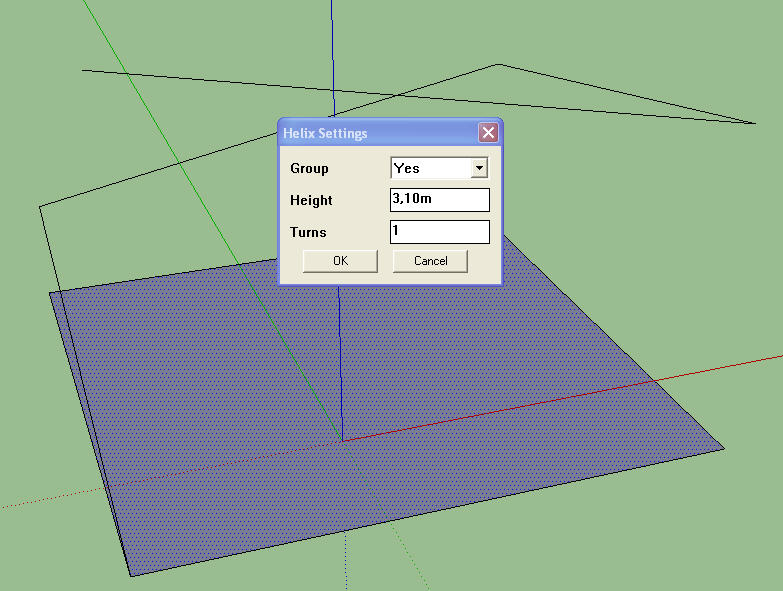
-
Erwin,
When we are at it, could you please, pass drawhelix13.rb to me? I have not been able to access the Ruby Depot for weeks now and lately I also needed it (after a HD crash and everything like that involved).
Thanks in advanace (until then I could not chime in anyway
 )
)But what if you chop the helix? It is just made up of segments like an arc or circle and if you draw a connecting line from any of its endpoints, it will break the helix there.
-
DrawHelix13.rb by Peter Brown 4/8/2004
has more options than that AND lets you do any number of turns...
http://www.crai.archi.fr/RubylibraryDepot/Ruby/drawhelix13.rb
Is this the one you are having problems with ?drawhelix13.rb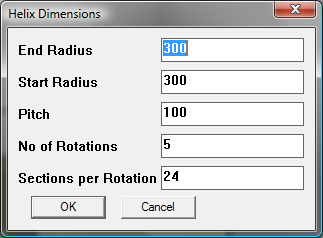
This is my version with new mm defaults etc but the original looks much the same... -
Thanks TIG.
Interesting that whenever someone links to a specific page in the Ruby Depot, I can open that link. However I cannot go to the front page - it just hangs there for me for ages.
-
@gaieus said:
Thanks TIG.
Interesting that whenever someone links to a specific page in the Ruby Depot, I can open that link. However I cannot go to the front page - it just hangs there for me for ages.Exactly the same here - resort to doing a Google search for what I want [drawhelix crai] then going straight to the linked page not through the front door so to speak !
-
Okay, 17 treads (I think that's the English term) for the total height of the helix. But how many degrees of turn?
-
@tig said:
DrawHelix13.rb by Peter Brown 4/8/2004
has more options than that AND lets you do any number of turns...
http://www.crai.archi.fr/RubylibraryDepot/Ruby/drawhelix13.rb
Is this the one you are having problems with ?[attachment=0:59tf7bb0]<!-- ia0 -->drawhelix13.rb<!-- ia0 -->[/attachment:59tf7bb0]Thanks for helping out.
I'm in need of this in order to draw a spiral stair.
But, I repeat, I CANNOT enter a value < 1 as a value for number of rotations ....Now I do realize that with differing settings depending on localization sometimes a [.] becomes a [,] just like, apparently sometimes in VCB you have to enter either [,] or [;] to distinguish between entries.
In this case I've tried all of them...No entry smaller than 1.
What am I doing wrong?Gaieus, chopping would work I assume, but I need my spiral stairs to have 17 marches or threads (?) (not sure about the naming in English
 ) and they need to sum up to the total arc length of the helix to be drawn....
) and they need to sum up to the total arc length of the helix to be drawn....I'm not quite there yet...
Apparently you can't enter anything other than a full integer in number of rotations or section per rotation.Erwin
-
Total of 324,431767 degrees
1 tread = 19,0842216 degrees -
Final result would be something like these...
Erwin
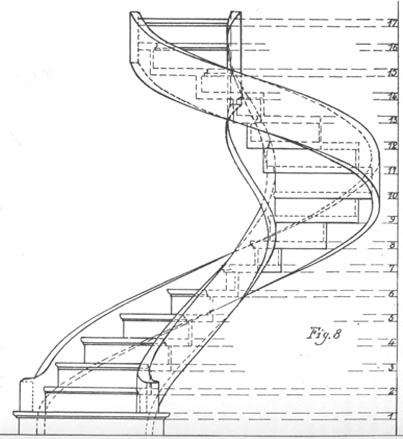
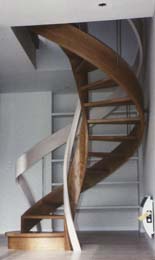
-
Done some more playing with 1001bit tools from Goh, and I think this will fit the bill.
Will have to do extensive editing, but with drawhelix13.rb or spiralstair11.rb this would have to be done too anyway..Would still be glad to see how to build a helix in less than a full turn

-
As I said, you can always break a helix - just like any other curve. I realise that these dimensions (324,xxx and 19,xxx degrees) are a bit "crazy" so to speak so I have been thinking hard how to achieve it (a simple segment count division would definitely not work - but it there were 18 treads and only 320 degrees, it would be easy).
-
@gaieus said:
As I said, you can always break a helix - just like any other curve. I realise that these dimensions (324,xxx and 19,xxx degrees) are a bit "crazy" so to speak so I have been thinking hard how to achieve it (a simple segment count division would definitely not work - but it there were 18 treads and only 320 degrees, it would be easy).
I've been following the same line of thought..
I did the math with numbers I got from a professional stairmaker, but I would like to 'build' the model in SU
I have to admit: I can find my way around SU more than average after a couple of months of SU-ing and sipping Aidan Chopra's excellent video's, but crunching these ruby plugins is a complete other cup of beans!
I've also tried to add a couple of treads, just to have > 1, but no comma allowed..I'd be glad to listen / read how you would go about with 17 treads and only 320 degrees...
Where would the difference be?Erwin
-
No 17 treads but say 16 - and as you can see from the picture, there is a very lowest tread which is not even too much part of the helix but a kind of pedestal like step so I believe the cheat would not even be that obvious as that can be added later.

-
Well, the pictures I posted are from the stairmakers website, so they don't correspond with our stair to be. We'd need to cover a height of 3100 mm in 17 treads, so each riser would need to be 182,35 mm. Also, there's something as the 'walkline' (translated literally, maybe it should be line of walk (?)) This line of walk would indicate that each tread be 230 mm across at a radius of 650 mm...
If I'm not mistaken you're thinkering of 16 or 18 to be a multiple of a pair?Erwin
-
Well, true that not exactlythe same dimensions... Especially the "walkline" - I used completely different measures so this is just an example.
The 18 is handy because 360 can be divided by 18. Then you take two of them and have a very similar number as your 324,xxx degrees (exactly 320).
When working with segmented curves in SU, it is extremely hard to count with those long decimal digits.
-
Had I realized you wanted to make 'spiral stairs' I would have suggested my 'Grow' tool...
Unzip this Grow.zip file and put the resultant Grow.rb into the Plugins folder and the growCursor.png into the Plugins/Icons folder [just as they are zipped].
The attached skps have some tutorials on how to make a helical [spiral] stair and also helices in general...Grow.zipGrowHelicalSteps.skpGrowHelix.skp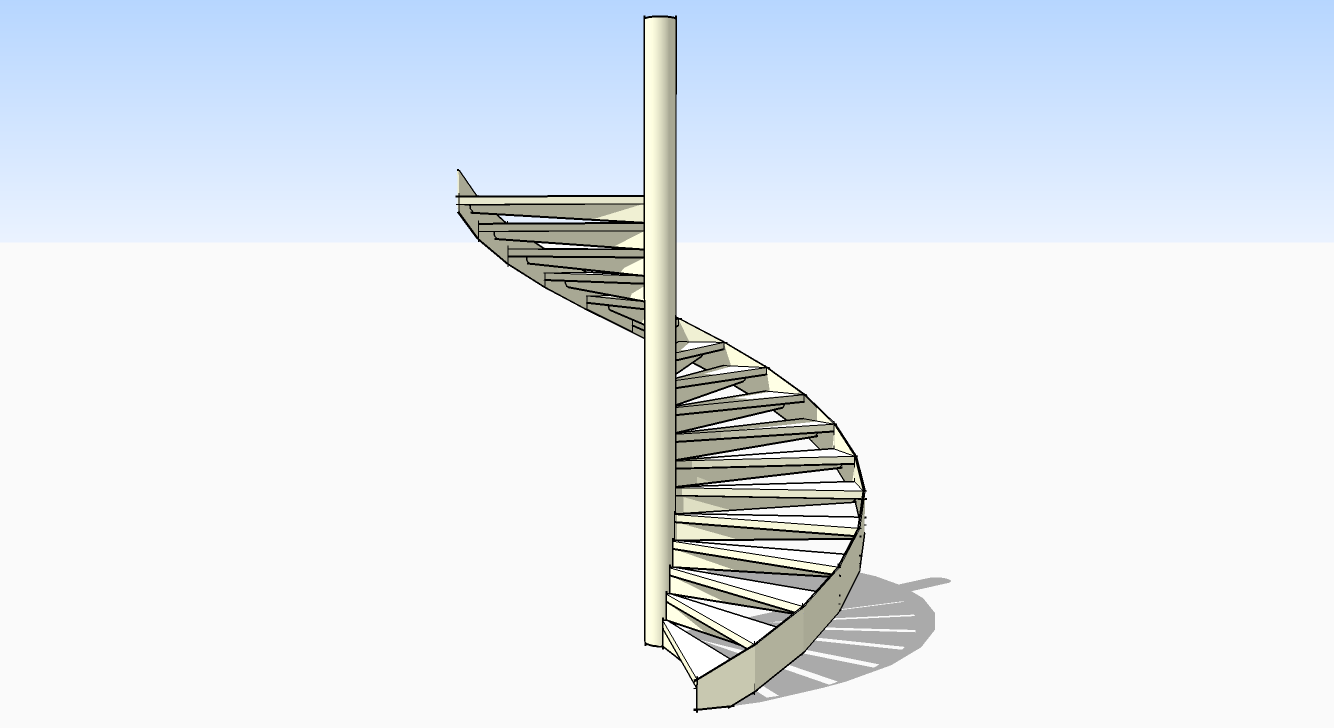
-
When making spiral steps there are often rules/codes to adhere to..
In the UK on narrower flights <1m [typically domestic or small commercial flights] you must have at least 50mm of plan-tread at the innermost part and the plan-tread on the centerline should be even for every step, and follow the rule 2R+G >=550mm <=700mm - where R is the Rise and G is the Going [plan-tread].
If you draw this in plan it limits the relative angle of adjacent nosings and effectively sets a limit on the taper angle between them = ~15degrees depending on the configuration etc...
For wider stairs you measure in from both edges [strings] 270mm and the same max/min pitch applies, 2R+G >=550mm <=700mm to the two locations
Any landings shall be the same length as their width measured along their centerline.
The minimum/maximum allowable Rise and Going varies with the building type too.
'Private Stair'[one dwelling] R >=155mm <=220mm and G >=223mm <=300mm [vertical pitch is also limited to 42 degrees - usually trapped by 2R+G rules]
'Institutional and Assembly Stair' R >=135mm <=180mm and G >=280mm <=340mm
'Other Stair' R >=150mm <=190mm and G >=250mm <=320mm
BUT AD-Part-M [accessible/disabled=all commercial/public building etc] R <= 170mm G >= 250mm
It's best to draw some test treads and place rotate a couple to see it they are right before committing to a complex 3D assembly...

-
I have fixed the problems with
drawhelix13.rb.
It now allows turns that are not whole numbers...
Here it isdrawhelix13_TIGd.rb
Advertisement







